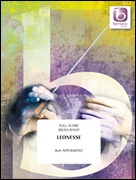Results
-
 £37.95
£37.95FATHER RHINE (Brass Band) - Lincke, Paul - Davies
Festival March
Estimated dispatch 7-14 working days
-
 £24.95
£24.95I HEAR YOU CALLING ME (Cornet/Brass Band) - Marshall, Charles
March card size
Estimated dispatch 7-14 working days
-
 £54.99
£54.99Inter-Pop (Brass Band - Score and Parts)
Five movements in techno-pop style. The work begins with Rock March with a few pithy chords over a driving percussion accompaniment. Feeling Free is a slow ballad. Rockarab is devoted to 'the ship of the desert', the camel. Little Chi Yan is a very charming, romantic song for a sweet little girl. In Disco Lights, we hear the stirring sounds of drums and bass guitar while the lights flash in the crowded discotheque. 05:20
Estimated dispatch 7-14 working days
-
 £37.95
£37.95INVICTUS (Brass Band) - Himes, William
Concert March. Recorded on Polyphonic QPRL042D A Touch More Spice
Estimated dispatch 7-14 working days
-
 £58.60
£58.60ITALIAN FANTASY (Brass Band) - Fernie, Alan
Medium Includes: Nessum Dorma; La Danza; O Sole Mio; Brindisi; Tourna A Surriento; Funiculi Funicula; Triumph March Aida
Estimated dispatch 7-14 working days
-
 £74.99
£74.99LEONESSE (Brass Band) - Appermont, Bert
Leonesse is the name of the castle and landed estates of Lady Guinevere, from the famous story of King Arthur. This stately concert march leads us to the old England with its legendary castles and the beautiful and impressive landscapes where many knights have died. Following a festive opening, a majestic melody symbolises the atmosphere of courtly elegance and refinement. The second part of this original composition describes, with a broad and dignified melody, the beauty and extensiveness of the English hills. Duration: 5:05.
Estimated dispatch 7-14 working days
-
 £24.95
£24.95MACUSHLA (Cornet/Brass Band) - MacMurrough, Dermot - Ord Hume, James
March card size
Estimated dispatch 7-14 working days
-
 £47.60
£47.60MARCHE DE LA POMME DE TERRE (Brass Band) - Ratnik, Peter
March of the Potato. Grade: easy.
Estimated dispatch 7-14 working days
-
 £59.99
£59.99Marching Blues (Brass Band - Score and Parts)
Marching Blues was written in the blues and swing-jazz style of the great big bands. It is an ideal show march that can be used for encores, popular performances, family concerts and much more. As an added entertaining feature why not get your Eb bass player to stand for his/her 28-bar solo! From small ensembles to large bands, Marching Blues will bring great joy to all generations of performers and audiences on many occasions. 04:00
Estimated dispatch 7-14 working days
-
 £38.80
£38.80O DU MEIN OESTERREICH (Brass Band Marchcard) - Preis, Ferdinand - Woodfield, Ray
March based on themes by Franz von Suppe. Marchcard size. Recorded on CD948 Spectacular Classics Vol.8. Grade: easy.
Estimated dispatch 7-14 working days
